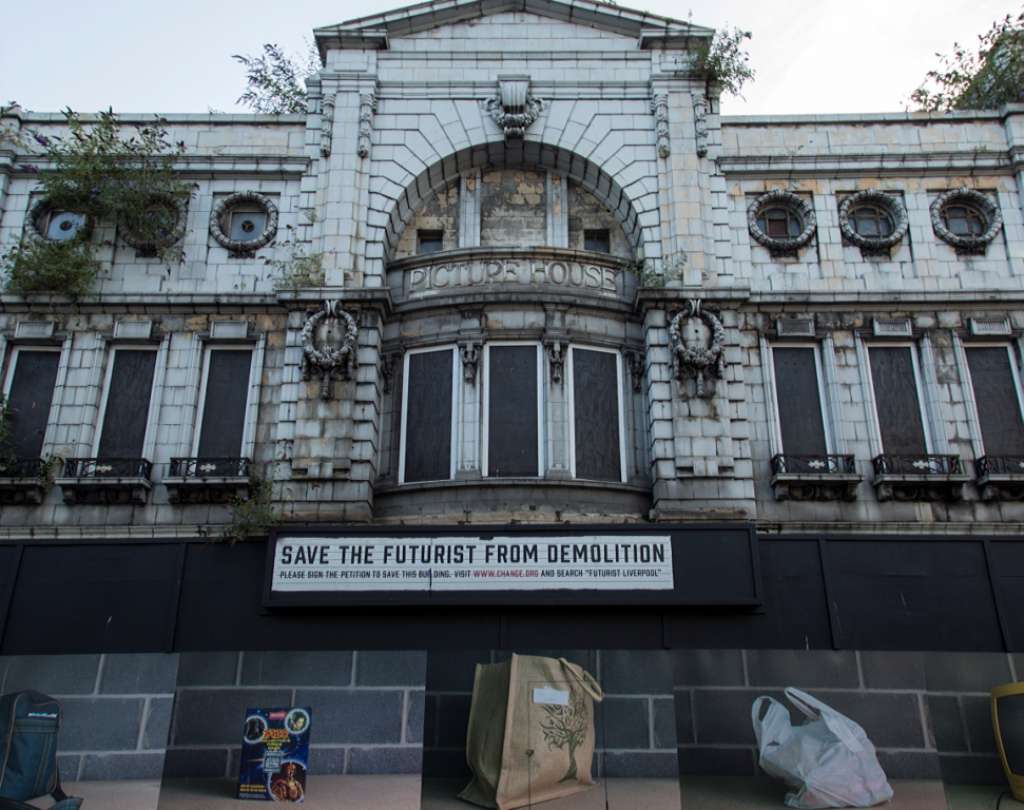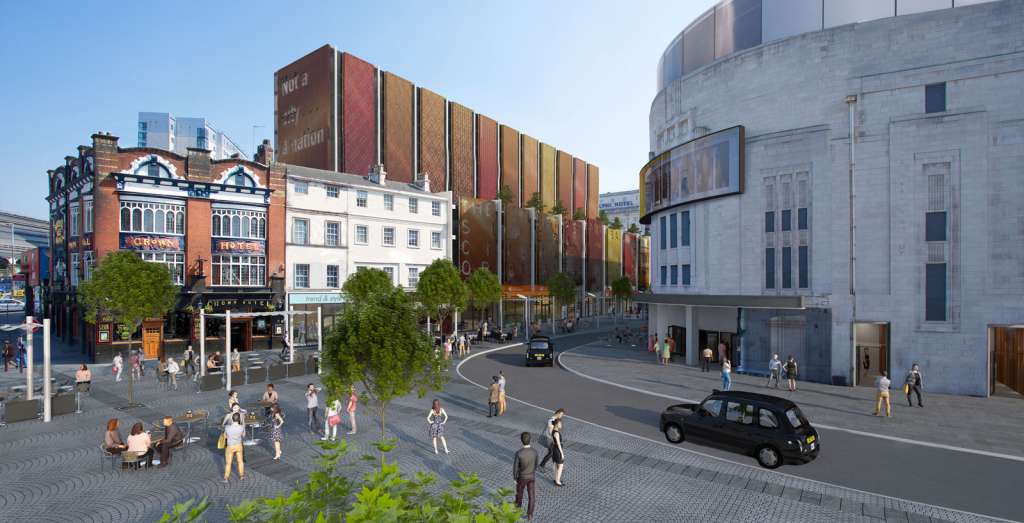Press release: SAVE goes to the High Court over Liverpool's Lime Street and Futurist Cinema
17 December 2015
PRESS RELEASE: SAVE GOES TO THE HIGH COURT OVER LIVERPOOL’S LIME STREET AND THE FUTURIST CINEMA
This Friday (18 December), the High Court in Manchester will hear SAVE’s challenge against Liverpool City Council’s decision to grant planning permission to Neptune Developments’ proposals to demolish over 10 buildings, including the Futurist Cinema, on Lime Street, for replacement with an overbearing 11-storey student block and shopping mall.
The area is in Liverpool’s World Heritage Site Buffer Zone and SAVE is challenging on the grounds that UNESCO and the Department for Culture Media and Sport (DCMS) were not consulted about the proposals. The proposed building exceeds the height recommendations for the area by four storeys, and will have a major and detrimental effect on the setting and Outstanding Universal Value of the World Heritage Site; all points raised in the objections of SAVE, the Victorian Society, the Merseyside Civic Society, The Cinema Theatre Association and many others.
English Heritage acknowledged in 2005 the importance of the buildings in question to the setting of the listed buildings and conservation area, and to the WHS:
[The Lime Street frontage] is “an important visual reminder that much of early C19 Liverpool was built to the same scale and density. The buildings provide the context for the listed public houses at either end of the building frontage, and for the railway terminus and former hotel at Lime Street Station. The range of architectural forms and detailing represented in the Lime Street frontage is an important contribution to the setting of the nearby conservation areas, and to that of the World Heritage Site.”
However, in their consultation response to these proposals they failed to make any reference at all to the fact that the site is in the WHS Buffer Zone, and they did not object to the application. This is a grave oversight, and begs the question, who is paying regard to the World Heritage Site regulations, to which the UK signed up to in 1984?
Equally, the DCMS failed to show any concern about the proposed construction in the Buffer Zone, effectively colluding with Liverpool Council in their decision that there was no need to consult. In its evidence Liverpool Council attempts to claim that the city was given World Heritage Site statement exclusively for its maritime mercantile heritage. In fact the WHS listing gives equal weight to Liverpool’s civic architecture that flourished at the same time.
Liverpool’s World Heritage Site was placed officially at risk by the UNESCO Committee in 2012 due to proposed tall building development on the waterfront, and there are concerns over the city and UK government’s lack of commitment to protecting the WHS, with the Mayor of Liverpool on record as describing the universal human value conferred and protected by WHS status as merely “a certificate on the town hall wall” (Liverpool Echo, January 2nd, 2012).
SAVE believes that the impact runs against World Heritage Site policy as enshrined in the UDP and NPPF, and places Liverpool’s already officially ‘endangered’ WHS at further risk. Deletion of the WHS by UNESCO would be only the third of its kind, and would be of great embarrassment to the UK Government for failing to uphold its treaty obligations to protect an asset of ‘outstanding universal human value’.
SAVE is challenging Liverpool Council’s claim that the proposed development will not affect the ‘Outstanding Universal Value’ of the WHS, even though they admit that it will affect its setting. SAVE holds that these two things cannot be divided and that setting is integral to OUV.
Lime Street is the thoroughfare from the station that leads up to Liverpool’s Cathedrals. It also leads into the Georgian area of the city, framing views of the Anglican cathedral tower (Grade I) and St. Luke’s Church (Grade II*) to the south, and St. George’s Hall (Grade I) and plateau, the Cenotaph (Grade I) Lime Street Station (Grade II) and the Walker Art Gallery (Grade II*), Picton Library (Grade II*) and County Sessions House (Grade II*) to the north.
SAVE is also concerned about the impacts of the development on Liverpool’s cultural heritage. Lime Street is one of Liverpool’s most famous streets – enshrined in the folk-song Maggie May, once a West End hit for Hollywood’s Judy Garland, and also because it shares a the name with Liverpool’s only surviving mainline Rail Terminus, and Alun Owen’s play ‘No Trams to Lime Street’.
The Futurist
The Futurist Cinema is a much loved Liverpool landmark: it is the city’s first purpose built cinema and one of a diminishing number of pre-WWI movie theatres in the UK. It was constructed in 1912 by renowned theatre architects Chadwick and Watson. It has a highly decorative façade of faience tiles.
International award-winning screen writer Frank Cottrell Boyce said: "This cinema is called the Futurist because it once represented the future when Liverpool led the world. I saw 2001: A Space Odyssey as a kid at the Futurist, which was full of visions of an amazing future. I still feel Liverpool's future could be different and amazing, and does not have to be about knocking down our historic buildings and putting up off-the-shelf student accommodation.
"Instead the Futurist could show the imaginative use of our heritage. It would be great to see its fine French Renaissance interior restored for use not just as a commercial cinema, but in an interesting and different way as a cinematic exhibition space for, say, I-Max or 3-D special features. Some of these could be aimed at visitors to tell Liverpool's story in a spectacular way.
"There's a future for these niche cinemas as seen in New York and Berlin. So why not make the Futurist into the UK's leader and put Liverpool ahead of the game again?"
Despite being mostly in city council freehold, and despite the fact that the council has a repairing lease on the Futurist, this historic gateway street has been left under-repaired and decaying for over two decades. It has been claimed that it is beyond repair, but an engineering report carried out in February by independent civil and structural engineers Sutcliffe’s stated that the ‘external façade was found to be in reasonable condition’.
Structural engineer Ed Morton made a statement ahead of proceedings: “To the Futurist Cinema it is clear that there has been a significant amount of water ingress which will of course have led to structural deterioration. However, in my experience, and with a carefully planned and methodical approach, it should be possible to repair and reinstate the structure, and I certainly cannot see the need to lose these buildings.
“Other buildings such as those shown in the Skates Witness Statement appear perfectly capable of repair and re-use and this must be more cost effective than demolition and re-building. There may be grants available to bridge conservation deficits subject to ownership and the aims of the owners.”
SAVE recognises the need to improve the area, but strongly condemns these plans to demolish rather than repair, and the deliberate neglect over many years of publicly owned heritage assets that should have been maintained under full repairing leases.
SAVE Director Clem Cecil said: “WHS UNESCO guidelines are being blatantly flouted. This could well be the last straw and lead to Liverpool having its World Heritage Site status removed, which would open the floodgates to inappropriate and harmful development throughout the city. That the WHS should be threatened due to a lack of coherent governance is shameful, both for Liverpool Council and the Government. This proposal on Liverpool’s gateway street reveals a lamentable failure of the system. By highlighting it we hope to save the street and prevent a repeat of this in the future.”
Merseyside Civic Society spokesman Jonathan Brown said: “The excuse that Lime Street needs demolition because it is scruffy is back to front. In fact of course, Lime Street is only scruffy precisely because it is slated for demolition – it’s an otherwise perfect location in terms of access, character and passing trade.
“Liverpool has a track record of working with innovative developers and designers like Urban Splash, Signature Living and Assemble – we’d like to see the council raise its game and encourage a better vision for Lime Street and the World Heritage Site that balances higher quality new-build with conservation of gems like the Futurist.”
SAVE President Marcus Binney says: "This is a grossly out of scale intrusion on one of the principal routes through the City making a nonsense of the World Heritage Site buffer zone."
For more information and images please contact the SAVE office on 0207 253 3500 or office@savebritainsheritage.org
Notes to Editors:
On 11th August Liverpool City Council voted to grant planning permission for the proposal. SAVE objected along with the Victorian Society, the Merseyside Civic Society and many others. SAVE offered meditation but Liverpool Council refused, following which SAVE served Judicial Review proceedings with Solicitor Susan Ring of Richard Buxton Environmental Law. We will be represented by Richard Harwood QC of 39 Essex Street.
SAVE Britain’s Heritage has been campaigning for historic buildings since its formation in 1975 by a group of architects, journalists and planners. It is a strong, independent voice in conservation, free to respond rapidly to emergencies and to speak out loud for the historic built environment.
SAVE Britain’s Heritage, 70 Cowcross Street, London EC1M 6EJ
Registered Charity 269129
Tel. 020 7253 3500 Email office@savebritainsheritage.org
www.savebritainsheritage.org
Follow SAVE on Twitter: @SAVEBrit
Donate to SAVE via Justgiving



